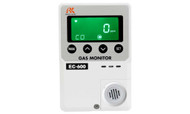Tips for Choosing a Fixed Gas Monitor for Workplaces
6th Feb 2024
Employees in certain workplaces, particularly in industries like manufacturing, chemical processing, or mining, may encounter hazardous gases that could be detrimental to their health and safety, as these gases could be flammable, explosive, or toxic. In these environments, employees rely on fixed gas monitors to alert them to potentially hazardous gas levels. Protect workers and assets by following these tips for choosing a fixed gas monitor for workplaces.
Understanding the Type of Gas To Monitor
Different gases require different types of monitors and detection methods. To effectively monitor air quality in your workplace, you must identify the gases that could be present. Some monitors detect a single type of gas, while others detect two or more gases.
Here are four types of gases that these detectors can monitor:
- Carbon Monoxide (CO): A colorless, odorless gas that can be harmful when inhaled in large amounts. It’s produced from burning carbon-containing materials.
- Ammonia (NH3): A colorless gas with a pungent smell. High exposure to ammonia can lead to serious health issues, including eye and lung irritation, and in extreme cases, it can be fatal.
- Hydrogen Sulfide (H2S): A toxic gas often found in industries such as wastewater treatment and petroleum refineries. Exposure to high levels of hydrogen sulfide can cause respiratory issues, dizziness, and even death.
- Oxygen (O2): Monitoring oxygen levels is crucial in environments where gas leaks or combustion processes could deplete oxygen, leading to an asphyxiation hazard.
Considering Device Features
When choosing a fixed gas monitor for your workplace, consider the features of the device. Qualities such as a robust alarm system, clear display screens, fast response times, and ease of use make the monitor more effective at protecting workers.
Choose a device that’s user-friendly and provides information in a way that’s easy to understand. An unnecessarily complex monitor can lead to misuse or misinterpretation of readings, which can put employees at risk of exposure to hazardous gases.
Consider the environment in which you’ll place the fixed gas detection system. A loud and visual alarm is particularly essential in noisy or dimly lit environments where workers may not be able to hear or see warnings clearly.
Ensuring Compliance With Safety Standards
A reliable gas detector is essential for complying with safety regulations and standards. In the US, the Occupational Safety and Health Administration (OSHA) has outlined specific permissible exposure limits (PELs) for various gases. An effective gas monitor should be capable of detecting concentrations over the PEL and alerting staff.
Compliant monitors meet the regulations stipulated by safety and health organizations, ensuring they provide reliable and accurate gas detection. Third-party testing and certification organizations may certify some monitors. Such certifications can provide an additional layer of assurance regarding the performance and reliability of the monitor in question.
Ensuring the safety of employees in risk-prone industries is a critical aspect of workplace management. An effective gas monitor detects target gases in its environment, has robust safety features and user-friendly design, and helps businesses comply with safety standards. By implementing effective gas monitoring, you not only protect your employees but also contribute to a functioning, productive, and legally compliant workplace.

